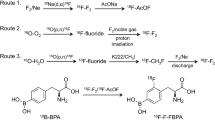Abstract
Objective
Although 2-18F-fluoro-2-deoxy-glucose (18F-FDG) has established roles in the diagnosis of a variety of cancers, it has limited value in the detection of primary/recurrent lesions in the bladder, mainly because of interference by the pooled radioactivity in the urine. Our previous study revealed promising properties of l- and d-2-18F-α-methyl-phenylalanine (2-18F-FAMP) as radiotracers; i.e., their rapid blood clearance and low renal accumulation. In the present study we evaluated the utility of l- and d-2-18F-FAMP for imaging bladder cancer in a mouse model.
Methods
We used the human bladder cancer cell line HT1376 to prepare a bladder cancer xenograft model in mice bearing both orthotopic and subcutaneous tumors. Biodistribution and PET imaging studies were performed at 1 and 3 h after injection of l-2-18F-FAMP or d-2-18F-FAMP. 18F-FDG was used as a control.
Results
At 1 h after injection, greater accumulations of both l-2-18F-FAMP and d-2-18F-FAMP were observed in the orthotopic tumors compared to 18F-FDG. The orthotopic tumor-to-muscle ratio of d-2-18F-FAMP was significantly higher than that of 18F-FDG (p < 0.01), because of the rapid blood clearance of d-2-18F-FAMP. l-2-18F-FAMP showed the highest subcutaneous tumor-to-muscle ratio (p < 0.01) due to its high subcutaneous tumor uptake. Compared to l-2-18F-FAMP, d-2-18F-FAMP exhibited faster clearance and lower kidney accumulation. In the PET imaging studies, l- and d-2-18F-FAMP both clearly visualized the orthotopic bladder tumors at 1 h after injection.
Conclusion
Our study showed that l-2-18F-FAMP and d-2-18F-FAMP have the potential to detect bladder cancer.






Similar content being viewed by others
References
Bray F, Ferlay J, Soerjomataram I, Siegel RL, Torre LA, Jemal A. Global cancer statistics 2018: GLOBOCAN estimates of incidence and mortality worldwide for 36 cancers in 185 countries. CA Cancer J Clin. 2018;68:394–424.
Kamat AM, Hahn NM, Efstathiou JA, Lerner SP, Malmström P-U, Choi W, et al. Bladder cancer. Lancet. 2016;388:2796–810.
Totaro A, Pinto F, Brescia A, Racioppi M, Cappa E, D’Agostino D, et al. Imaging in bladder cancer: present role and future perspectives. Urol Int. 2010;85:373–80.
Choe J, Braschi-Amirfarzan M, Tirumani SH, Shinagare AB, Kim KW, Ramaiya NH, et al. Updates for the radiologist in non-muscle-invasive, muscle-invasive, and metastatic bladder cancer. Abdom Radiol. 2017;42:2710–24.
Alfred Witjes J, Lebret T, Compérat EM, Cowan NC, De Santis M, Bruins HM, et al. Updated 2016 EAU guidelines on muscle-invasive and metastatic bladder cancer. Eur Urol. 2017;71:462–75.
Avril N. GLUT1 expression in tissue and 18F-FDG uptake. J Nucl Med. 2004;45:930–3.
Razik A, Das C, Sharma S. PET-CT and PET-MR in urological cancers other than prostate cancer: an update on state of the art. Indian J Urol. 2018;34:20.
Schöder H, Larson SM. Positron emission tomography for prostate, bladder, and renal cancer. Semin Nucl Med. 2004;34:274–92.
Achmad A, Bhattarai A, Yudistiro R, Heryanto YD, Higuchi T, Tsushima Y. The diagnostic performance of 18F-FAMT PET and 18F-FDG PET for malignancy detection: a meta-analysis. BMC Med Imaging. 2017;17:66.
Watabe T, Ikeda H, Nagamori S, Wiriyasermkul P, Tanaka Y, Naka S, et al. 18F-FBPA as a tumor-specific probe of L-type amino acid transporter 1 (LAT1): a comparison study with 18F-FDG and 11C-Methionine PET. Eur J Nucl Med Mol Imaging. 2017;44:321–31.
Maimaiti M, Sakamoto S, Sugiura M, Xu M, Yamada Y, Higuchi K, et al. An L-type amino acid transporte 1 inhibitor: JPH203 suppresses bladder cancer growth and invansion via IGFBP-5. J Urol. 2019;201:e724.
Hanaoka H, Ohshima Y, Yamaguchi A, Suzuki H, Ishioka NS, Higuchi T, et al. Novel 18F-labeled α-methyl-phenylalanine derivative with high tumor accumulation and ideal pharmacokinetics for tumor-specific imaging. Mol Pharm. 2019;16:3609–16.
Ferreira-Teixeira M, Parada B, Rodrigues-Santos P, Alves V, Ramalho JS, Caramelo F, et al. Functional and molecular characterization of cancer stem-like cells in bladder cancer: a potential signature for muscle-invasive tumors. Oncotarget. 2015;6:36185–201.
Fu C-L, Apelo CA, Torres B, Thai KH, Hsieh MH. Mouse bladder wall injection. J Vis Exp. 2011;53:1–3.
Jäger W, Moskalev I, Janssen C, Hayashi T, Awrey S, Gust KM, et al. Ultrasound-guided intramural inoculation of orthotopic bladder cancer xenografts: a novel high-precision approach. PLoS ONE. 2013;8:e59536.
Abbas A, Beamish C, McGirr R, Demarco J, Cockburn N, Krokowski D, et al. Characterization of 5-(2–18F-fluoroethoxy)-l-tryptophan for PET imaging of the pancreas. F1000Research. 2016;5:1851.
Nijjar S, Patterson J, Ducharme J, Leslie WD, Demeter SJ. The effect of furosemide dose timing on bladder activity in oncology imaging with 18F-fluorodeoxyglucose PET/CT. Nucl Med Commun. 2010;31:167–72.
Anjos DA, Etchebehere ECSC, Ramos CD, Santos AO, Albertotti C, Camargo EE. 18F-FDG PET/CT delayed images after diuretic for restaging invasive bladder cancer. J Nucl Med. 2007;48:764–70.
Hanaoka H, Ohshima Y, Suzuki Y, Yamaguchi A, Watanabe S, Uehara T, et al. Development of a widely usable amino acid tracer: 76Br-α-methyl-phenylalanine for tumor PET imaging. J Nucl Med. 2015;56:791–7.
GuhaSarkar S, Banerjee R. Intravesical drug delivery: challenges, current status, opportunities and novel strategies. J Control Release. 2010;148:147–59.
Ohshima Y, Hanaoka H, Tominaga H, Kanai Y, Kaira K, Yamaguchi A, et al. Biological evaluation of 3-[18F]fluoro-α-methyl-d-tyrosine (D-[18F]FAMT) as a novel amino acid tracer for positron emission tomography. Ann Nucl Med. 2013;27:314–24.
Acknowledgements
We thank Mr. Takashi Ogasawara (Cyclotron Facility, Gunma University Hospital) for producing the 18F-FAMPs and 18F-FDG. No potential conflicts of interest were disclosed.
Author information
Authors and Affiliations
Corresponding author
Additional information
Publisher's Note
Springer Nature remains neutral with regard to jurisdictional claims in published maps and institutional affiliations.
Rights and permissions
About this article
Cite this article
Mahendra, I., Hanaoka, H., Yamaguchi, A. et al. Diagnosis of bladder cancer using 18F-labeled α-methyl-phenylalanine tracers in a mouse model. Ann Nucl Med 34, 329–336 (2020). https://doi.org/10.1007/s12149-020-01452-z
Received:
Accepted:
Published:
Issue Date:
DOI: https://doi.org/10.1007/s12149-020-01452-z




